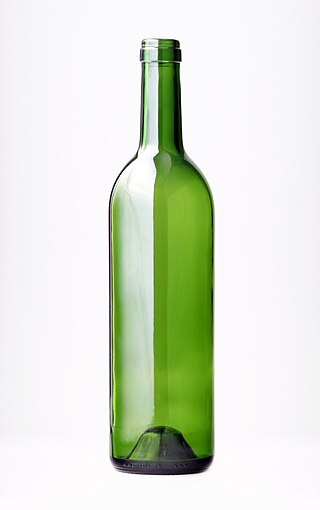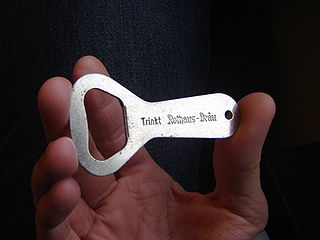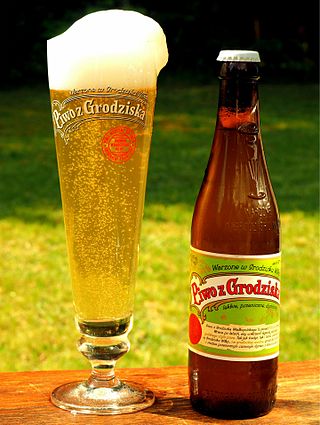Related Research Articles

A bottle is a narrow-necked container made of an impermeable material in various shapes and sizes that stores and transports liquids. Its mouth, at the bottling line, can be sealed with an internal stopper, an external bottle cap, a closure, or induction sealing.
A screw cap or closure is a common type of closure for bottles, jars, and tubes.

A drink can is a metal container designed to hold a fixed portion of liquid such as carbonated soft drinks, alcoholic drinks, fruit juices, teas, herbal teas, energy drinks, etc. Drink cans are made of aluminum or tin-plated steel. Worldwide production for all drink cans is approximately 370 billion cans per year.

An Aluminum can is a single-use container for packaging made primarily of aluminum. It is commonly used for food and beverages such as olive and soup but also for products such as oil, chemicals, and other liquids. Global production is 180 billion annually and constitutes the largest single use of aluminum globally.

A bottle cap or bottle top is a closure for the top opening of a bottle. A cap is sometimes colorfully decorated with the logo of the brand of contents. Plastic caps are used for plastic bottles, while metal with plastic backing is used for glass; plastic caps are commonly made from polyethylene or polypropylene, while metal caps are usually either steel or aluminum. Plastic caps may have a pour spout. Flip-Top caps like Flapper closures provide controlled dispensing of dry products. Caps for plastic bottles are often made of a different type of plastic from the bottle.

Grolsch Brewery , known simply as Grolsch, is a Dutch brewery founded in 1615 by Willem Neerfeldt in Groenlo. In 1895 the de Groen family bought the brewery. They had started their own brewery in Enschede in the early 19th century. It held a significant stake until November 2007. Today the main brewery is located in Enschede.

Bottling lines are production lines that fill a product, generally a beverage, into bottles on a large scale. Many prepared foods are also bottled, such as sauces, syrups, marinades, oils and vinegars.

A beer bottle is a bottle designed as a container for beer. Such designs vary greatly in size and shape, but the glass commonly is brown or green to reduce spoilage from light, especially ultraviolet.

A bottle opener is a device that enables the removal of metal bottle caps from glass bottles. More generally, it might be thought to include corkscrews used to remove cork or plastic stoppers from wine bottles.

A closure is a device used to close or seal a container such as a bottle, jug, jar, tube, or can. A closure may be a cap, cover, lid, plug, liner, or the like. The part of the container to which the closure is applied is called the finish.

A keg is a small barrel.
Crown Holdings, Inc., formerly Crown Cork & Seal Company, is an American company that makes metal beverage and food cans, metal aerosol containers, metal closures and specialty packing. Founded in 1892, it is headquartered in Yardley, Pennsylvania. As of their annual report for 2020, Crown employs 33,264 people at 192 plants in 39 countries. It claims to manufacture one out of every five beverage cans used in the world, and one out of every three food cans used in North America and Europe. The company is ranked No. 286 in the Fortune 500 list for 2022 and is number one in the packaging and container industry for the same list.

A glass bottle is a bottle made from glass. Glass bottles can vary in size considerably, but are most commonly found in sizes ranging between about 200 millilitres and 1.5 litres. Common uses for glass bottles include food condiments, soda, liquor, cosmetics, pickling and preservatives; they are occasionally also notably used for the informal distribution of notes. These types of bottles are utilitarian and serve a purpose in commercial industries.

A church key or churchkey is a North American term for various kinds of bottle openers and can openers.

The Beer Can Museum, located in East Taunton, Massachusetts, is a collection of more than 5,000 different beer cans, along with beer can folk art and crafts, beer can clothing, beer can telephones and radios, and a beer can and breweriana related library. In November 2013, it was included in Travel & Leisure's list of 'America's Strangest Museums.'

Induction sealing is the process of bonding thermoplastic materials by induction heating. This involves controlled heating an electrically conducting object by electromagnetic induction, through heat generated in the object by eddy currents.

Grodziskie is a historical beer style from Poland made from oak-smoked wheat malt with a clear, light golden color, high carbonation, low alcohol content, low to moderate levels of hop bitterness, and a strong smoke flavor and aroma. The taste is light and crisp, with primary flavors coming from the smoked malt, the high mineral content of the water, and the strain of yeast used to ferment it. It was nicknamed "Polish Champagne" because of its high carbonation levels and valued as a high-quality beer for special occasions.

A flip-top, swing-top, lightning toggle, or Quillfeldt stopper is a type of closure frequently used for bottles containing carbonated beverages, such as beer or mineral water. The mouth of the bottle is sealed by a stopper, usually made of porcelain or plastic, fitted with a rubber gasket and held in place by a set of wires. The bottle can be opened and resealed repeatedly and without the use of a bottle opener, with the wires acting in the same way as a latch clamp. The flip-top was the dominant method of sealing beer and mineral water bottles prior to the invention of the crown cork.

A growler (US) is a glass, ceramic, or stainless steel bottle used to transport draft beer. They are commonly sold at breweries and brewpubs as a means to sell take-out craft beer. Rarely, beers are bottled in growlers for retail sale. The significant growth of craft breweries and the growing popularity of home brewing has also led to an emerging market for the sale of collectible growlers. Some U.S. grocery stores, convenience stores, bars and restaurants have growler filling stations.
References
- ↑ Soroka, Walter (2008). Illustrated Glossary of Packaging Terminology. DEStech Publications, Inc, ISBN 9781930268272
- ↑ Yam, Kit L. (2010). The Wiley Encyclopedia of Packaging Technology. John Wiley & Sons, ISBN 9780470541388
- ↑ Walter, James (2011). Drinkology Beer: A Book About the Brew. Abrams, ISBN 9781584798514
- 1 2 3 4 "What are Cone Top Beer Cans?". www.ebeercans.com. Retrieved 2023-09-20.